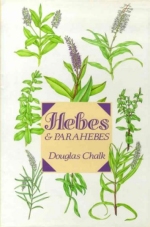BOOK REVIEWSBy Douglas Chalk, 152 pages. Reviewed by Tony Hayter
(aj.me.hayter@boltblue.com) Douglas Chalk was a founder member and Vice President of the Hebe Society . Hebes and Parahebes was the first book on hebes. It was published in 1988 in New Zealand, the United Kingdom, and the United States, and is now out of print. Douglas's book appropriately
enough has a foreword by Lawrie Metcalf. Chapter 1 has a brief introduction
to New Zealand and a comparison of growing conditions in New Zealand,
North America and the British Isles. In chapter 2 Douglas describes
the change of name from Veronica to Hebe, the
differences between Veronica and Hebe, and the
splitting of the sub-shrubby genus of Parahebe from both
Veronica and Hebe. Chapter 3 explores the features
of hebes: the variety of size, shape and colour of leaves, leaf
bud sinus, colour of stems, times of flowering, colour of flowers,
types of inflorescences. Lastly there is a table of 46 hebes and
2 parahebes with their sizes, flower colour, leaf colour and
times of flowering. The growing of hebes and parahebes is described
in chapter 4. Here Douglas considers soil types, frost, wind, preparation
for planting, shelter belts, pruning, and lastly pests and diseases.
In chapter 5 he discusses the propagation of hebes and parahebes
from seed, cuttings and layering. Chapter 6 is devoted to hebe nomenclature.
Douglas in chapter 7 advises on which hebes and parahebes to grow
in a variety of situations: troughs, ground cover, borders, coastal
areas, and hedges. In chapter 8, the largest chapter, Douglas describes nearly 300 species, varieties and cultivars of Hebe. The description is usually a paragraph or two. Sixty hebes are illustrated in colour, thirty as line drawings. Chapter 9 discusses the Chionohebe species and chapter 10 the Parahebe species and cultivars. |
Home | Journal
| Newsletter | Conferences
Awards | Join
RNZIH | RNZIH Directory | Links
© 2000–2025 Royal New Zealand Institute of Horticulture
Last updated: March 1, 2021


